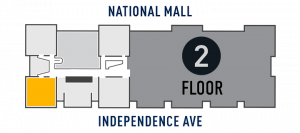The Gas Chromatograph Mass Spectrometer (GCMS) experiment was carried aboard each of the Viking spacecraft landers that reached the red planet in 1976. It was intended to detect evidence of bological material in the Martian soil. It took a small soil sample, separated volatile elements using a gas chromatograph, and analyzed their composition with a mass spectrometer. It provided a way of resolving any ambiguities that might arise from the three biology experiments - the gas exchange (GEX) experiment, the labeled release experiment, and the pyrolitic release experiment.
While the GCMS found no trace of biological processes on the surface of Mars, scientist Gilbert Levin believes that the GCMS instrument sent to Mars could easily have missed biologically significant amounts of organic matter in the soil, as it had in a number of tests on Earth.
This Viking Gas Chronometer Mass Spectrometer is identical to the instruments on Mars that were used to measure the composition of the atmosphere and search for organic compounds in the Martian soil.
Display Status
This object is on display in Kenneth C. Griffin Exploring the Planets Gallery at the National Air and Space Museum in Washington, DC.

Object Details
Country of Origin
United States of America
Type
SPACECRAFT-Uncrewed-Instruments & Payloads
Manufacturer
Litton Systems, Inc.
Dimensions
Overall: 1 ft. 1 in. × 1 ft. 6 in. × 1 ft. 1 in., 25.4kg (33 × 45.7 × 33cm, 56lb.)
Materials
HAZARD: Thorium (thoriated magnesium)
Mixed metals, electronics, and plastics
Inventory Number
A19800074000
Credit Line
Transferred from National Aeronautics and Space Administration and Jet Propulsion Laboratory
Data Source
National Air and Space Museum
Restrictions & Rights
Usage conditions apply
For more information, visit the Smithsonians Terms of Use.
